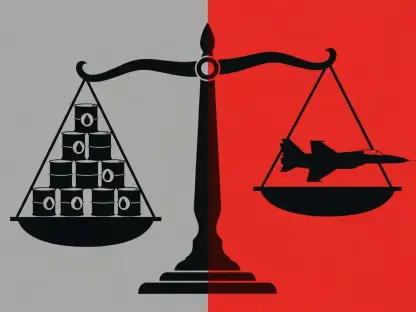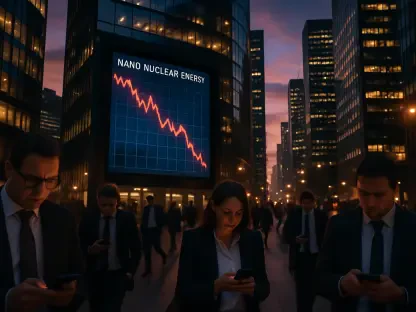In a landscape where energy policy is constantly shifting to meet modern demands, a transformative development has surfaced with the Federal Energy Regulatory Commission (FERC) issuing a landmark ruling on October 1 of this year. This ruling, known as Order No. 914, introduces conditional sunset dates for a select group of regulations, signaling a profound change in the management of energy rules across the nation. Stemming from an Executive Order released by the Trump administration earlier in April, this directive pushes for a significant reduction in regulatory burdens within the energy sector. The move raises compelling questions about its impact on industry stakeholders, everyday consumers, and the delicate power dynamics between federal agencies and executive authority. As this policy unfolds, it promises to redefine the framework of energy oversight, potentially altering the balance between innovation and accountability in a sector critical to economic and environmental stability.
This latest step by FERC isn’t merely administrative housekeeping; it’s a deliberate stride toward deregulation with far-reaching consequences. By targeting 53 specific regulations for expiration within a year unless extended through public consultation, the order reflects a broader ambition to streamline operations and cut compliance costs for energy firms. Yet, it also sparks curiosity about whether such rapid deregulation might compromise necessary oversight, particularly in areas like electricity transmission and natural gas markets. The initiative’s roots in an executive mandate further complicate matters, challenging the historical independence of FERC and setting the stage for a deeper examination of regulatory governance in the energy realm.
Understanding the Executive Order’s Push for Deregulation
Background and Intent
A pivotal force behind FERC’s recent actions is the Executive Order titled “Zero-Based Regulatory Budgeting to Unleash American Energy,” issued by the Trump administration in April of this year. This directive aims to dismantle regulatory constraints perceived as barriers to energy sector growth by requiring federal agencies to impose sunset provisions on existing rules related to energy production. Under this mandate, regulations are set to expire after one year unless affirmative steps are taken to extend them, following an evaluation of their costs and benefits. This approach seeks to foster a more dynamic energy market by reducing bureaucratic obstacles, prioritizing economic expansion and resource development over extensive regulatory frameworks. The order’s emphasis on reassessing rules through a cost-benefit lens underscores a policy shift toward efficiency and industry support, potentially reshaping how energy projects are initiated and managed across the country.
Equally significant is the mechanism embedded within the Executive Order for public involvement in the regulatory review process, which ensures that diverse perspectives are considered in critical decision-making. Agencies are instructed to provide opportunities for stakeholders to comment on the impacts of affected regulations, ensuring that varied viewpoints inform decisions about whether rules should sunset or be retained with modifications. This provision for public input aims to balance the drive for deregulation with a degree of transparency, allowing industry players, consumer advocates, and other interested parties to weigh in on the real-world implications of regulatory changes. By mandating such engagement, the directive attempts to mitigate the risk of hasty eliminations that could disrupt market stability or consumer protections, setting a framework where deregulation is pursued with a measure of accountability to the broader public.
Challenge to FERC’s Independence
The Executive Order’s direct targeting of FERC, an agency historically recognized for its independence from executive directives, marks a notable departure from traditional regulatory dynamics. Unlike other federal entities more closely tied to presidential authority, FERC has long maintained that compliance with executive orders is voluntary, rooted in its statutory role to operate free from partisan or administrative overreach. This new mandate, however, explicitly includes FERC in its scope, raising intricate legal and practical questions about the extent to which executive power can influence independent regulatory bodies. The tension between adhering to this directive and preserving autonomous decision-making underscores a critical debate about the boundaries of agency authority in shaping energy policy under external pressures.
This development also prompts a closer look at the historical context of FERC’s interactions with executive mandates. Over the years, the agency has navigated its independent status by selectively engaging with presidential directives, often aligning with broader policy goals only when they coincide with its mission to ensure fair and reliable energy markets. The current Executive Order, with its specific instructions for regulatory sunset provisions, tests this precedent by imposing a structured timeline and process that FERC must address. The resulting compliance, though seemingly pragmatic, hints at potential shifts in how independent agencies might be directed in the future, possibly setting a benchmark for increased executive influence over sectors traditionally insulated from such oversight, thereby reshaping the governance landscape for energy regulation.
FERC’s Response Through Order No. 914
Details of the Order
In direct response to the April Executive Order, FERC issued Order No. 914 on October 1 of this year, a significant ruling that applies conditional sunset provisions to 53 regulations identified as outdated, redundant, or no longer relevant. These rules are set to expire 365 days after the order’s effective date, which occurs 45 days following its publication in the Federal Register, provided no substantial adverse comments are received within a 30-day window. This structured timeline reflects FERC’s attempt to align with the executive mandate while maintaining a degree of procedural rigor. The targeted regulations span various aspects of energy oversight, from natural gas to electricity transmission, signaling a comprehensive effort to purge regulatory clutter that may hinder industry efficiency. This order represents not just a policy update but a fundamental rethinking of how energy rules are sustained or discarded in response to evolving market needs.
Alongside the issuance of Order No. 914, FERC introduced a Notice of Proposed Rulemaking (NOPR) within the same docket to address potential opposition or unforeseen consequences of the sunset provisions. This parallel action serves as a contingency plan; if significant pushback emerges during the comment period, the order could be reconsidered or even rescinded, triggering a formal proceeding to reassess the elimination of the listed regulations. Such a dual approach highlights FERC’s recognition of the complexity involved in altering longstanding rules and the necessity of adapting to feedback from affected parties. By embedding this flexibility, the agency aims to ensure that the deregulation process does not inadvertently destabilize critical components of the energy sector, maintaining a cautious balance between compliance with the executive directive and its duty to safeguard market integrity.
Safeguards and Public Input
A cornerstone of Order No. 914 is its incorporation of mechanisms designed to facilitate public engagement and prevent abrupt regulatory changes, ensuring that the process remains transparent and inclusive. The order mandates comment periods during which stakeholders can submit feedback on the costs, benefits, and broader impacts of the regulations slated for sunset. This process allows for a thorough evaluation of each rule’s relevance, ensuring that the voices of energy companies, consumer groups, and other entities are considered before final decisions are made. Additionally, the provision for extending sunset dates by up to five years offers a critical safety net, permitting FERC to retain rules that, upon review, are deemed essential despite initial assessments of obsolescence. This structured approach to public input reflects a commitment to transparency and fairness in the deregulation effort.
Beyond the immediate comment mechanisms, the potential rescission of Order No. 914 in the face of substantial opposition underscores FERC’s responsiveness to stakeholder concerns, ensuring that the agency remains attentive to the needs of all parties involved. If the feedback gathered through the NOPR reveals widespread issues with the proposed sunsetting of regulations, the agency retains the authority to halt or revise the order, initiating a more comprehensive rulemaking process to address the highlighted challenges. This safeguard ensures that the push for a leaner regulatory framework does not come at the expense of necessary oversight or market stability. By prioritizing dialogue and adaptability, FERC aims to navigate the complexities of deregulation with a measured hand, striving to align industry needs with the public interest while adhering to the overarching goals set forth by the Executive Order.
Justifications for Sunsetting Regulations
Categories of Targeted Rules
Order No. 914 zeroes in on 53 regulations for sunset provisions, with FERC citing several distinct reasons for their proposed expiration, ranging from obsolescence to irrelevance in today’s energy landscape. Many of these rules are tied to outdated technologies or statutory frameworks that no longer apply, such as provisions linked to repealed laws like the Powerplant and Industrial Fuel Use Act. Others pertain to market structures that have evolved significantly, particularly in the natural gas sector, where pipelines have been functionally unbundled from production and sales activities, rendering certain oversight measures unnecessary. Additionally, some regulations are flagged for redundancy, duplicating requirements already addressed elsewhere in FERC’s framework, such as overlapping filing obligations. These categories collectively paint a picture of a regulatory system burdened by relics of past contexts, prompting a necessary overhaul to reflect current realities.
Delving deeper into specific examples, FERC identifies rules like outdated filing requirements that demand paper submissions of maps and diagrams, which are cumbersome in the digital age. Other targeted regulations include transitional provisions that were relevant only for brief historical periods, now serving no practical purpose. There are also notice requirements and procedural mandates that have been consistently waived or ignored in practice, diminishing their utility. By highlighting such cases, FERC builds a case for sunsetting as a means of eliminating bureaucratic dead weight that neither supports market efficiency nor protects consumer interests. This detailed categorization underscores the agency’s intent to focus on regulations that fail to align with modern operational or legal standards, ensuring that the sunset process targets only those rules genuinely out of step with today’s energy environment.
Practical Impact of Streamlining
The primary aim of sunsetting these 53 regulations under Order No. 914 is to alleviate compliance burdens that energy companies face, often grappling with outdated or duplicative rules that inflate operational costs without delivering proportional benefits. By removing such regulations, FERC anticipates a more streamlined oversight framework that reduces administrative overhead, potentially freeing up resources for innovation and infrastructure investment within the sector. For electricity and natural gas providers, this could translate into lower barriers to market entry or expansion, fostering competition and possibly benefiting consumers through enhanced service options or pricing. The initiative reflects a pragmatic approach to regulatory reform, prioritizing efficiency in a sector where agility is increasingly vital amid technological advancements and shifting energy demands.
However, the streamlining effort is not without potential pitfalls that could impact both industry and public stakeholders. If critical regulations are sunset without suitable replacements or thorough evaluation, gaps in oversight might emerge, leading to market uncertainty or diminished protections for consumers against price volatility or service disruptions. Such risks are particularly acute in areas where regulations, though seemingly outdated, might still serve niche but important functions in maintaining system reliability. FERC’s challenge lies in ensuring that the drive for a leaner regulatory environment does not inadvertently compromise the stability of energy markets, necessitating careful monitoring and readiness to adjust course based on feedback and outcomes. This balance between cutting excess and preserving essentials remains a critical consideration as the sunset provisions take effect.
Broader Implications for Energy Policy
Trends in Deregulation
Order No. 914 fits squarely within a larger political and economic trend toward deregulation, particularly in the energy sector, where reducing bureaucratic constraints is seen as a catalyst for growth. The underpinning Executive Order reflects a clear priority to boost energy production by minimizing regulatory oversight, aligning with industry aspirations for fewer hurdles in developing new projects or expanding existing operations. This policy direction suggests a future where energy firms might enjoy greater flexibility to innovate, potentially accelerating the deployment of new technologies or infrastructure critical to meeting rising demand. By positioning deregulation as a driver of economic vitality, the initiative underscores a belief that a lighter regulatory touch can unlock significant investment and job creation within the sector, reshaping how energy policy is crafted and implemented.
This push for deregulation also resonates with broader industry goals to prioritize efficiency over expansive government intervention. Energy companies, often vocal about the costs of compliance with intricate rules, stand to gain from a framework that pares down unnecessary mandates, allowing for quicker decision-making and resource allocation. However, this trend raises questions about the long-term impacts on environmental standards and consumer safeguards, areas where regulation often plays a protective role. As FERC moves forward with Order No. 914, the energy sector watches closely to see how this deregulatory wave influences not just operational dynamics but also the balance between market freedom and public accountability, potentially setting a tone for regulatory approaches across other industries as well.
Future of Agency Autonomy
The compliance of FERC, an independent agency, with the Executive Order signals a noteworthy shift in the dynamics of regulatory governance, raising questions about the future autonomy of similar bodies. Historically insulated from direct executive control, FERC’s decision to align with this mandate may establish a precedent for future administrations to exert greater influence over independent regulators, particularly in strategic sectors like energy. This development prompts speculation about whether such actions could erode the traditional separation that allows agencies to prioritize technical expertise and public interest over political agendas. The implications of this shift extend beyond immediate policy changes, potentially redefining how regulatory decisions are shaped and contested in the coming years across various federal domains.
At the heart of this issue lies the delicate balance between executive authority and FERC’s statutory mandate to ensure fair, reliable energy markets. While compliance with the current directive appears to align with broader deregulation goals, it also underscores the tension between following executive guidance and maintaining independent judgment on complex regulatory matters. The precedent set by Order No. 914 could embolden future executive actions to test the boundaries of agency independence, challenging FERC and similar entities to navigate an evolving landscape where political priorities increasingly intersect with regulatory functions. As this unfolds, the energy sector and beyond will likely scrutinize how this balance is maintained, ensuring that the public interest remains a guiding principle amid pressures for streamlined governance.
Reflecting on Regulatory Evolution
Looking back, the issuance of Order No. 914 on October 1 marked a defining chapter in energy policy, responding to an Executive Order that sought to reshape the regulatory environment through targeted sunset provisions. FERC’s effort to sunset 53 outdated or redundant rules illustrated a calculated push toward efficiency, driven by justifications rooted in obsolescence, market evolution, and procedural redundancy. The integration of public comment periods and extension options demonstrated a commitment to accountability, even as the agency adhered to a directive that tested its independent status. This moment in regulatory history captured a nuanced struggle between streamlining oversight and preserving essential protections, reflecting broader tensions in governance.
Moving forward, stakeholders must actively engage in the feedback mechanisms provided by FERC to ensure that the sunset process does not overlook critical regulations. Industry players should prepare for a leaner compliance landscape by reassessing operational strategies, while consumer advocates need to monitor potential impacts on service reliability and pricing. Policymakers, meanwhile, should consider frameworks that support deregulation without sacrificing market stability, possibly through phased transitions or pilot programs for regulatory removal. As the energy sector adapts to these changes, ongoing dialogue among all parties will be essential to refine this evolving policy, ensuring that the pursuit of efficiency enhances rather than undermines the public good.









